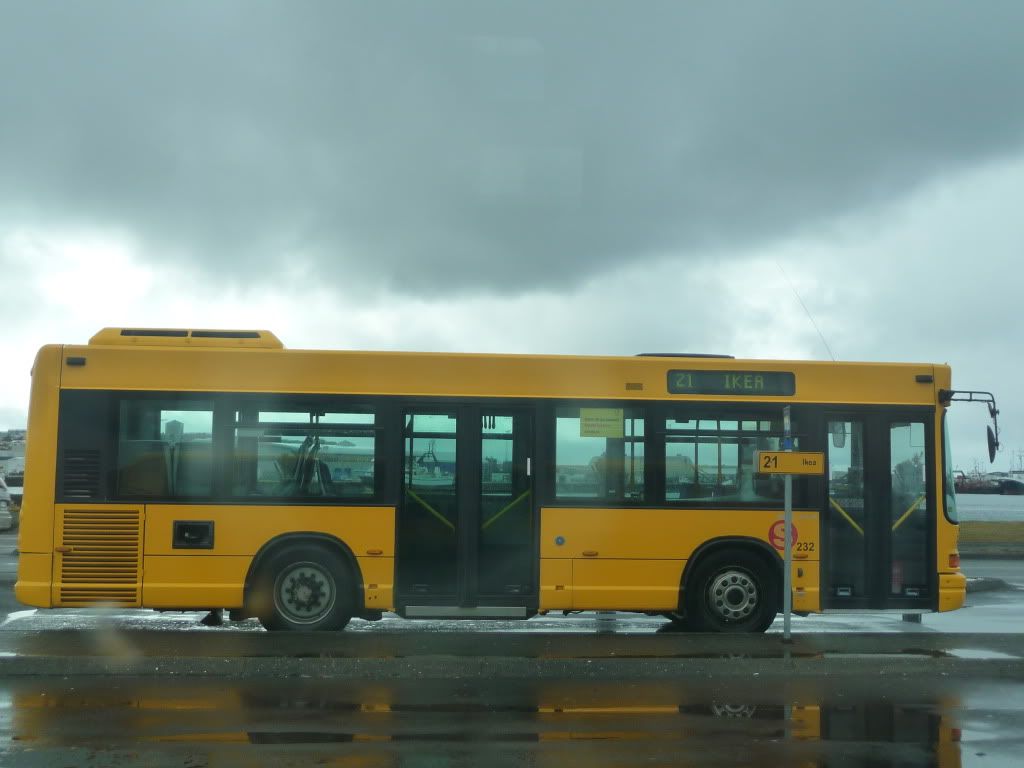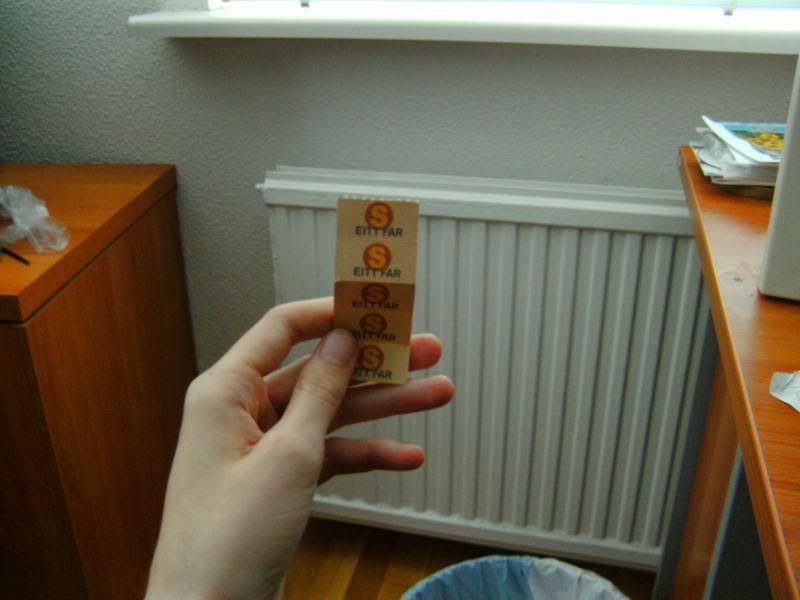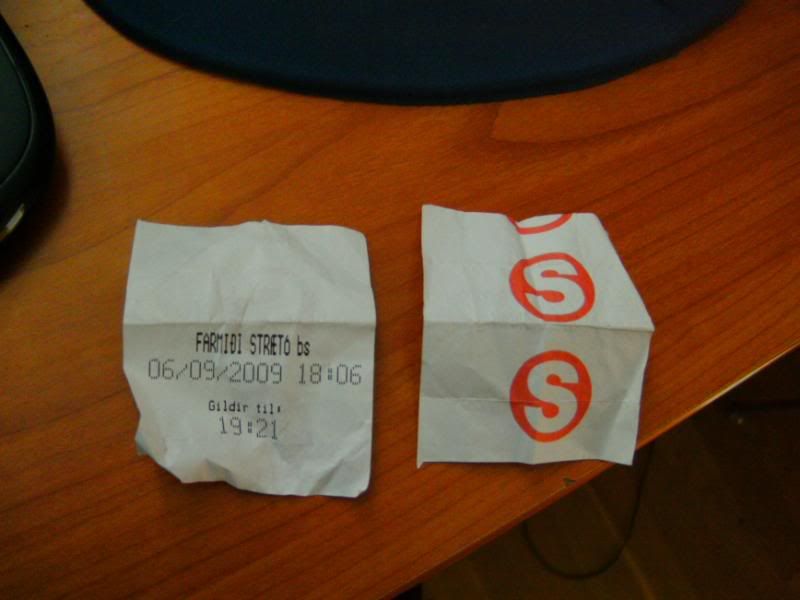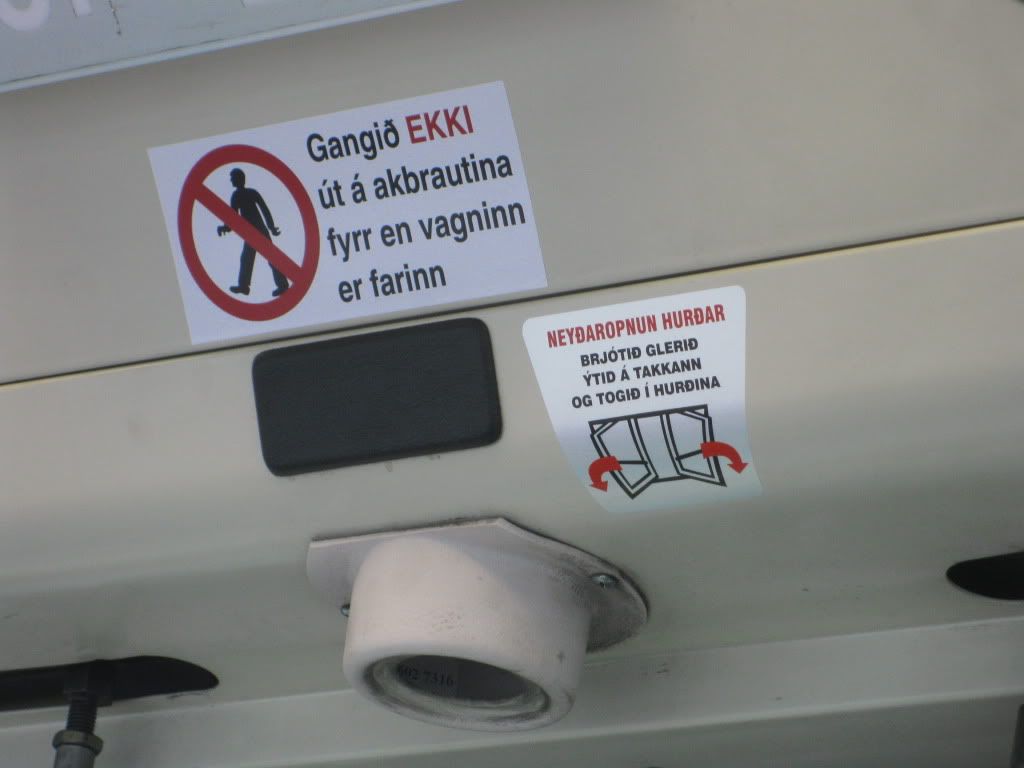Busses in Iceland Posted by sequoia on Sep 29, 2011 in Uncategorized
Right now I have a three-day job of counting who comes on and off the bus. There’s a few different types of busses – the yellow busses are city busses, their website is straeto.is and they have a “S” logo. (I’m going to start linking to the English section of a website if possible just because sometimes it’s hard to find while the Icelandic one is just the regular main page.) You pay for this bus either by showing your bus card, paying with cardboard tickets that you can buy at bus stations, or putting your coins (the bus driver can’t give you change so either pay exact or overpay) into a plastic box with a slit in it that’s in front of the driver.
There’s another bus, called the Flybus, which drives from the Keflavík airport to BSÍ (the bus terminal – don’t know what it stands for) in Reykjavík, just a few blocks away from the hospital and a few blocks more from downtown Reykjavík. You don’t have to preorder bus tickets for the Flybus.
My friend took the flybus and paid via the internet. At the end of the airport, near the exit hall and near the meeting place with the revolving door to go outside, there’s a “hole in the wall” sort of kiosk for the flybus. You give them your booking numbers (that you got from the internet) and they give you a bus ticket. Then you go out through some glass doors and the busses are right outside the doors. Just ask and any employee should be able to tell you where to go. When you arrive at BSÍ, it’s a bus station with a building. Inside the building is a small shop with food (they serve sheep’s heads if I remember correctly) and a few rows of seats where people can wait.
For the regular bus, right now the cost is 350kr for an adult. You can ask for a bus transfer from the driver which lasts something like an hour, but they won’t give it to you automatically. (Ask with a word like “miði, ticket / má ég fá miða, may I get a ticket?”). Bus drivers usually don’t have good English, while some might be able to understand you others might not.

Inside of a regular bus. Unfortunately I don’t have a photo of the coin box (while I’m doing this job I get to stay in the bus if the driver is taking a break, but I don’t want to move up to the front to take photos in case they think I’m trying to steal coins or something).

This sign changes according to what the next stop is. The words will turn from orange to red when the bus is right at the bus stop. When it changes to a new location, a voice will read aloud “næsta stopp er… / next stop is…” and the stop name on the sign will change. Leið means route, so this bus is on route one (the l is cut off by that metal bar).

These figures are something like the mascots of the bus company, if you buy a bus card they’ll be on the back of it.

These red buttons are what you push to alert the bus driver that you want to stop at the next stop. When you push them, “stansar / will stop” will appear in red on the electronic sign.
My job for counting people has me stay on one bus route for a few hours, and on every stop I count how many people get on and off. Here’s the rules (although you don’t have to speak Icelandic to get the job):

I stay on the bus and when it gets to the end of the route, the bus driver generally takes a break for a few minutes before coming back onto the bus and going in the other direction. Yesterday when the driver did this he invited me into a little shack for bus drivers, to have coffee. I got to take photos of the shack:

This is the outside (that isn’t the driver who invited me in though, this was taken on another day).

Inside there’s a coffee machine and a little fridge that had milk to put in our coffee.

Above the cupboards. If anything, this is just proof that you can probably be a bus driver without speaking Icelandic. If you’re able to drive and can drive in heavy winds, rain, ice, and the dark, it’s possible!

To the left side of this photo was a billboard with “Attention employees, make sure you…” sorts of papers.
To the other side was a door, I don’t know where it went. There was a bathroom connected to the side of the room that you might be able to see from the photo of the outside of the shack, the bathroom is the door on the left while these photos are from the door on the right.

The other side of the room. The bus driver talked to me in Icelandic and asked if I was an exchange student – the only thing I said in English was “I’ve been here for one year” but he understood it. He didn’t say anything in English. We stayed there for about fifteen minutes then went back on the bus.
EDIT: On another day I had the same bus driver and he talked mostly in English this time. He said he has a brother who works at the military base so it’s good if he practices English, because sometimes he visits his brother at work. He understood everything I said, his grammar was just a little bad. I could understand most of his Icelandic because he spoke really clearly to me. He said he thinks Icelandic is a hard language to learn because of how complicated the grammar is, which is a sentiment I’ve been hearing from practically every Icelander on the subject.
If you want to (or if you miss your stop) you can stay on the bus after it reaches the end of the route, and keep riding when it turns around. You won’t have to pay again.

Build vocabulary, practice pronunciation, and more with Transparent Language Online. Available anytime, anywhere, on any device.
About the Author: sequoia
I try to write about two-thirds of the blog topics on cultural aspects and one-third on the language, because there's much more out there already on the language compared to daily life information. I try to stay away from touristy things because there's more of that out there than anything else on Iceland, and I feel like talking about that stuff gives you the wrong impression of Iceland.


















